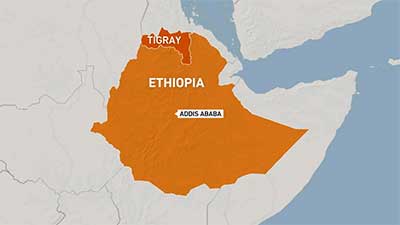Daily-current-affairs /
18 Nov 2020
Ethiopian Crisis : Daily Current Affairs

Ethiopian Crisis
Why in NEWS ?
- UNHCR is warning that a full-scale humanitarian crisis is unfolding as
thousands of refugees flee ongoing fighting in Ethiopia’s Tigray region
each day to seek safety in eastern Sudan.
About
- A “full-scale humanitarian crisis” is unfolding in Ethiopia, the United
Nations refugee agency said , with more than 27,000 now having fled heavy
fighting to Sudan.
- Ethiopians fled the ongoing fighting in Tigray region, prepare to cross
the Setit River on the Sudan-Ethiopia border in Hamdait village in eastern
Kassala state
- The pace of the exodus, some 4,000 a day, may also indicate “massive
displacement” within the Tigray region.
- Ethiopia’s prime minister warned that a deadline for rebel northern
forces to lay down arms had expired, paving the way for a final push on the
Tigray region’s capital in a two-week conflict destabilising the Horn of
Africa.
- UNHCR is on stand-by to provide assistance in Tigray when access and
security allow.
Tigray People’s Liberation Front (TPLF)
- The TPLF was founded in 1975 as a resistance army of the Tigrayan people
against the military dictatorship, which was called the Derg.
- The leftist Derg, which was established in 1974, would change its title
in 1987 but practically remained in power till it was ousted by the armed
rebels in 1991.
- The TPLF played a crucial role in ousting the junta and they were
welcomed as national heroes in 1991.
- TPLF leader Meles Zenawi took over as the interim President in 1991 and
became the first elected Prime Minister in 1995.
- He is largely seen as the architect of the country’s ethno-federal
system and remained in power till 2012.
- But over the years, the government led by the Ethiopian People’s
Revolutionary Democratic Front (EPRDF), a coalition put together by Mr.
Zenawi, was accused of being increasingly authoritarian and there were
frequent mass protests in the regions.
- Though the EPRDF contains regional political parties such as the Amhara
Democratic Party, the Oromo Democratic Party and the Southern Ethiopian
People’s Democratic Movement, the TPLF remained the dominant political
force.
- In 2018, the EPRDF chose Mr. Abiy, a former military intelligence
officer, to lead the government amid growing protests and a political
deadlock.
Rise of Abiy
- Though the EPRDF provided a stable rule with high economic growth for 17
years, there was mounting criticism against the country’s ethno-federal
arrangement.
- The Tigray people make up roughly 6% of the population, while the Oromos
have a 34% share and the Amharas 27%.
- While the TPLF controlled the levers of power through the EPRDF, the
Oromos alleged marginalisation.
- As Prime Minister, Mr. Abiy purged TPLF functionaries from key
government posts, released political prisoners (jailed by the TPLF-led
government) and promised freer media.
- He reached out to Eritrea, a sworn enemy of the TPLF, which shares a
long border with the Tigray region.
War Conflict
- The TPLF saw the formation of a new party as an attempt by Mr. Abiy to
consolidate more power in hands.
- On November 3, TPLF militants attacked a federal military command in the
Tigray region and captured military hardware and equipment, prompting Mr.
Abiy to declare the military operation.
- Mr. Abiy’s outreach to Eritrea had outraged the TPLF, which had fought a
prolonged war with the Eritrean government along the Tigray border.
- The rebels fired rockets into Eritrea from Tigray, threatening a wider
regional war in the Horn of Africa. Tigray rebels also fired rockets into
the neighbouring Amhara region.
- The Tigray region shares a border with Sudan. The TPLF enjoyed good
relations with Sudan’s ousted dictator Omar Bashir.
- Sudan has a border dispute with Ethiopia. If Sudan’s new rulers
(the transition government includes civilian and military leaders) keep the
old links with the TPLF active and the border open for the rebels, the
conflict could go on.
- If it does, it could derail Mr. Abiy’s reform agenda at home as well as
the diplomatic agenda abroad.
Root of Ethiopia-Sudan border dispute
- Sudan and Ethiopia share a common boundary that stretches over 1,600
kilometers (994 miles).
- The border was drawn following a series of treaties between Ethiopia and
the colonial powers of Britain and Italy. However, to date, this boundary
lacks clear demarcation lines.
- Sudan’s al-Fashqa region which covers approximately 600 km, is a rich
fertile land conducive for agriculture. For decades, Ethiopia has allowed
its farmers to plant crops there.
- Former Sudanese President Omar al-Bashir largely turned a blind eye to
his country’s territorial incursion. However, Sudan’s transitional
authorities, who took over after popular protests which eventually led to
the ousting of al-Bashir, have initiated talks with Ethiopia in a bid to
have to Ethiopian farmers withdraw.








